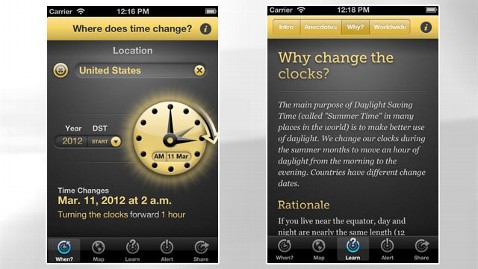By Tenshi Kyurei (DANIEL BEAN)
March 8, 2013

Never mind the snowy weather across the country -- it's time to spring forward this weekend, believe it or not. Daylight saving time begins Sunday at 2 a.m. local time in all but a few parts of the U.S.
The bad news: You will still lose an hour this Sunday morning.
The good news: With each passing year, there is less and less need to
worry about that "don't forget to move your clocks forward an hour"
part.
With more and more people using radio clocks (sometimes inaccurately called atomic clocks),
clocks on mobile phones and clocks on any other online device like a
cable box or computer, switching to and from daylight saving time has
become less of a chore.
For those who still have off-the-grid clocks, there are plenty of mobile
phone and tablet apps that will kindly remind you to spring forward or
fall back when the time comes. The iOS app SpringAhead from IDEA.org even provides some fun facts and info about which parts of the world make the time change.
SpringAhead from IDEA.org (Image credit: Apple)
Although it's probably news to most U.S. east coasters, there are
actually some parts of the country that don't observe daylight saving
time. Hawaii, most of Arizona, Puerto Rico, the Virgin Islands, American
Samoa, Guam and the Northern Marianas do not participate, according to Weather.com.
But, no matter which way your clocks are adjusted, moving into daylight saving time means a loss of sleep for many.
Dr. Raghu Upender, medical director of the Vanderbilt Sleep Disorders
Center, told ABC News that it's best to try to stick to your normal
weekday sleep schedule during the "spring forward" weekend.
"People tend to delay their sleep during the weekend and tend to go into
Monday with less sleep. This can be exaggerated on the Monday following
the change to daylight saving time," Upender said.
For those who have traditionally struggled with the jump into daylight
saving, Upender suggests going to bed a bit sooner, beginning several
days prior to the time change. Calling it a night 15 minutes earlier the
first day, and then an additional 15 minutes earlier for each
successive night up until the Saturday before the time change can help
make up for the jump ahead in time, according to Upender.
But why all this trouble anyhow? The idea of saving daylight time can be traced back to the 18th century.
"Ben Franklin is generally considered the person who came up with the
concept of waking up earlier for making better use of the sun," David
Prerau, author of "Seize the Daylight: The Curious and Contentious Study of Daylight Saving Time," told ABC News.
Although Franklin had several ideas about how to get people to wake up
earlier (firing cannons in quiet neighborhoods is Prerau's favorite), he
never considered adjusting clocks. Vernon Hudson and William Willard
were among the first to suggest the idea of actually changing the time
of day, though neither had success in having the idea adopted by their
countries of residence, Hudson in New Zealand or Willard in Britain,
Prerau said.
It wasn't until World War I that nations around the globe began to use
daylight saving time. "As soon as the Germans decided to put in daylight
saving time, the British implemented it three weeks later," Prerau
said.
The U.S. first officially passed daylight saving time with the Standard
Time Act in 1918. Since then, daylight saving has been repealed,
reinstated for World War II, and finally etched firmly into a
comprehensive law with with the Uniform Time Act in 1966. Each state can
decide whether or not to participate, but those that do must conform to
the nationally directed timeframes.
Since 2007, daylight saving time in the U.S. has run from the second Sunday of March to the first Sunday of November.

